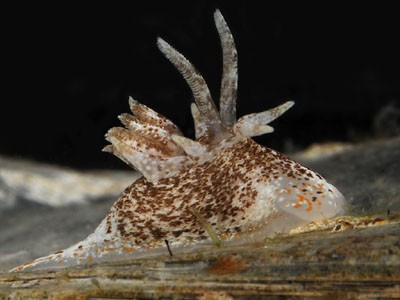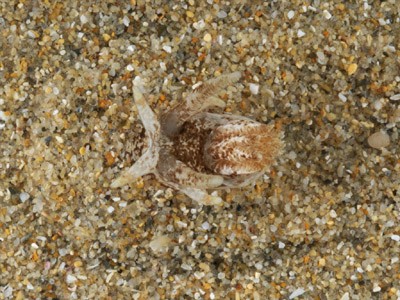Okenia rhinorma from S.E. Australia
January 18, 2010
From: John Chuk

Dear Bill,
This animal was a surprise find! It was spotted at night crawling on a silty sand bottom. I assume it is Okenia rhinorma? The first image is a lab shot of the specimen.
On being placed on sand in an aquarium the specimen immediately buried itself up to the level of the pallial processes and proceeded to plough through the sand at a reasonable pace. The second image is a lab shot of the partially buried specimen in motion.
It would appear that the pallial processes act to deflect sand away from the mantle surface when the animal is in motion. When the specimen came to rest it buried itself deeper in the sand with just the gills and tips of rhinophores exposed.
Locality: Blairgowrie, 9m, Victoria, Australia, Port Phillip Bay, 20 December 2009, silty sand. Length: 18.5mm. Photographer: John Chuk.
I am sending another two messages with further information on this species [#23110; #23111].
Best wishes,
John.
jchuk@optusnet.com.au
Chuk, J., 2010 (Jan 18) Okenia rhinorma from S.E. Australia. [Message in] Sea Slug Forum. Australian Museum, Sydney. Available from http://www.seaslugforum.net/find/23109
Dear John,
Thanks for this interesting record. It is indeed O. rhinorma. It is amazing to think that until a couple of years ago the only examples of this species we knew about was a specimen I found in Dar es Salaam, Tanzania and a photo from the Red Sea. We now have records from the Indian Ocean across to tropical Japan and Australia. I must say I wasn't expecting it to occur in temperate Australia. I don't know if its appearance in Port Phillip Bay is the result of larvae travelling in ballast water or from global warming, or whether it is a 'natural' but irregular visitor.
The apparent burrowing behaviour is unusual but it could be a result of being in an unnatural environment. I suspect the sand is much looser than where you found it in the field, and it has sunk down into the sand until it has found the hard glass bottom. This species is very similar in shape to a few northern hemisphere species such as O. aspersa, O. leachi, O. ascidicola, O. elegans and O. pulchella. They are all relatively large with a high profile and all seem to feed on ascidians. Your other two messages showing the shape of the egg ribbon and it feeding on large solitary ascidians are both new observations for the species. These features confirm its link to the similarly-shaped species listed above.
Best wishes,
Bill Rudman
Related messages
-
Okenia rhinorma feeding
From: John Chuk, January 18, 2010 -
Egg-laying Okenia rhinorma
From: John Chuk, January 18, 2010 -
Okenia rhinorma found sthn Queensland
From: Gary Cobb, October 28, 2009 -
Okenia rhinorma from Lembeh, Indonesia
From: Bill Rudman, October 3, 2008 -
Okenia rhinorma from Hachijo Is., Japan
From: Bill Rudman, February 9, 2008 -
Re: Okenia rhinorma - another new Okenia
From: Binyamin Koretz, December 11, 2007 -
Okenia rhinorma from the Red Sea
From: Binyamin Koretz, December 10, 2007 -
Okenia rhinorma - another new Okenia
From: Bill Rudman, December 10, 2007 -
Thecacera from Lembeh
From: Danny Van Belle, January 16, 2003 -
Okenia? from Hachijo Is., Japan
From: Nishina Masayoshi, July 13, 2001
